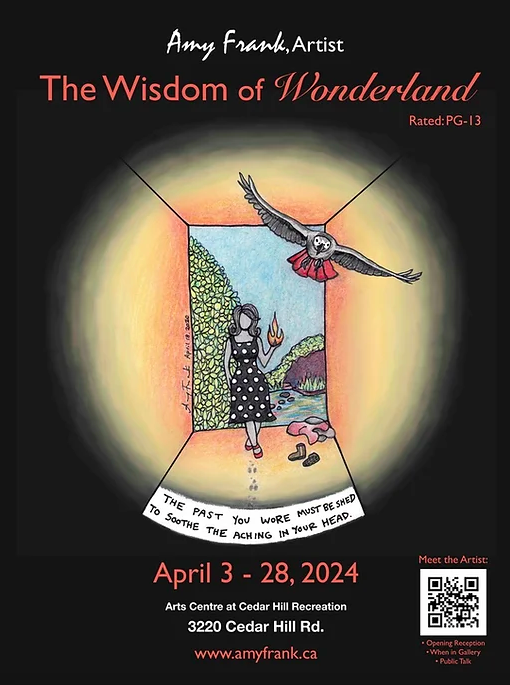The Wisdom of Wonderland explores mental health issues and provides hope for those struggling

Photo via amyfrank.ca.
Amy Frank is a Victoria-based artist whose exhibition, The Wisdom of Wonderland, is currently on display at the Cedar Hill Recreation Centre. She recently sat down with the Martlet to discuss her art and experiences creating it.
This interview has been edited for clarity and brevity.
Tell me a bit about yourself.
I work as a visual artist and mental health advocate here in Victoria. I’ve been doing it since 2011, since I was 25.
What can you tell me about your new exhibit, The Wisdom of Wonderland?
The Wisdom of Wonderland is a collection of my pieces from across my art portfolio to date. As a youth, I could draw realistically quite well — I could do realism by the age of 11. Then, when I started showing symptoms of mental illness in my teenage years, my work shifted into surrealism. No matter where I’ve been on my mental health journey, my art has reflected that.
The Wisdom of Wonderland is broken into sections. It starts in the preteen years, then it moves into the teenage years, then to when my art career beg[an] at 25, and then it moves around the room to where I am today.
In 2019, I entered a drug-induced psychosis caused by marijuana, which was an adventure that I aptly named Wonderland. I was in psychosis for at least two years until 2021, when I started coming out of it. My adventure in Wonderland, as I called it, kind of crash landed into reality after I was detained under B.C.’s Mental Health Act, where I was force-injected with medication for over a year, which was a truly traumatic experience and nearly took my life. I’m using my work to advocate for psych patient rights.
How do you think art helped you through your experience with psychosis?
I think art has been a really great avenue to express those weird mindsets. In 2019, I started doing something in my art that I called Art as Therapy. Basically, they’re just little sketchbooks that I started keeping when I started going into the psychosis. The point of these sketchbooks was to get away from creating art with the intent to sell. It didn’t matter if it was good. It didn’t matter what the subject matter was. Nobody even had to see it. I could just create it for me. That’s kind of where I’m at today — I’m still creating Art as Therapy.
It was very liberating. I was able to use these Art as Therapy books as a way to rewrite endings — it was a cognitive behavioral therapy in a way. I could reframe my thoughts. I could rewrite the story.
What advice do you have for someone who wants to start creating art, but feels unsure of their abilities?
I meet people all the time who tell me they’re not artists. The only thing that makes you an artist is that you’re creating art. It has nothing to do with technique, or style, or whether it’s good or not. That’s your own personal judgment. You can create, and it doesn’t have to be seen. It doesn’t have to be spectacular. It’s the act of creating, it’s not the final outcome. It’s just like life, right? Life is the journey, not the outcome.
What’s your favourite piece from the exhibit?
One of my favorite pieces in the exhibit is called “Fledgling,” and it’s a self-portrait I did of myself and my pet parrot. Her name is Saba. It’s a black and white piece done in 2014, and I have a red flower in my hair. Another favorite would be “Hesitation,” which is a soldier. It’s a very meaningful piece to me.
Tell me more about your work in mental health advocacy.
When I was first diagnosed with bipolar disorder when I was 18, I carried a lot of shame around that diagnosis. So when I was about 22, I purchased the domain amyfrank.ca, and I built my first website. I really didn’t want to live with that shame anymore. So I thought, you know, I’m just going to start talking about it. I candidly share my own story, in hopes that it will connect with other people.
The Wisdom of Wonderland is on display until April 28 at the Arts Centre of Cedar Hill Recreation Centre. To check the exhibition’s hours, or for more information, visit amyfrank.ca.








